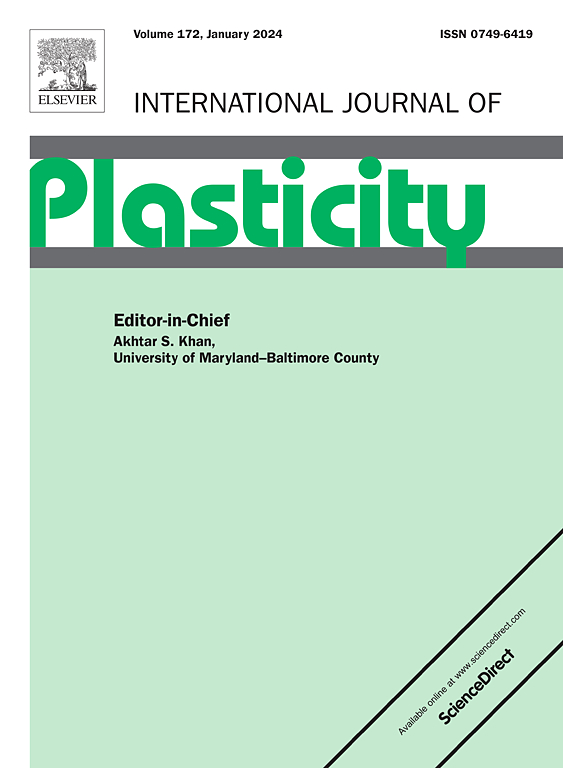Mesoscopic origin of damage nucleation of Mg-RE-Zn alloys containing LPSO phase
IF 9.4
1区 材料科学
Q1 ENGINEERING, MECHANICAL
引用次数: 0
Abstract
The role of the long-period stacking order (LPSO) phase in damage initiation within magnesium alloys remains inadequately understood. This study investigates the influence of the LPSO phase on damage nucleation and toughness in Mg-RE-Zn alloys, utilizing in-situ tensile testing combined with scanning electron microscopy and digital image correlation (SEM-DIC) to capture mesoscale strain distribution. Results identify the incoherent α-Mg/LPSO interface as the primary site of damage due to its inherent weakness. Damage nucleation is driven by strain gradients resulting from strain localization, which is governed by the strain compatibility factor (mk value) and associated with high local stress from dislocation accumulation. Secondary damage occurs within LPSO blocks, where their higher elastic modulus prevents stress relief through plastic deformation. Thermo-mechanical processing offers strategies to mitigate these issues by enhancing intergranular strain compatibility (increasing mk values through grain orientation adjustments) and refining LPSO blocks to improve dispersion strengthening. These measures help counteract the reduction in plasticity caused by damage at the α-Mg/LPSO interface. Furthermore, the main damage nucleation model provides a predictive framework for identifying potential decohesion sites at incoherent α-Mg/LPSO interfaces based on mk values and grain orientation.

含LPSO相Mg-RE-Zn合金损伤形核的介观成因
长周期堆积相(LPSO)在镁合金损伤萌生中的作用尚不清楚。本研究利用原位拉伸试验、扫描电镜和数字图像相关(SEM-DIC)技术捕捉中尺度应变分布,研究了LPSO相对Mg-RE-Zn合金损伤成核和韧性的影响。结果表明,非相干α-Mg/LPSO界面由于其固有的弱点而成为主要的损伤部位。损伤成核是由应变局部化引起的应变梯度驱动的,应变局部化受应变相容性因子(mk值)的控制,并与位错积累引起的高局部应力有关。二次损伤发生在LPSO块内,其较高的弹性模量阻止了通过塑性变形释放应力。热机械加工提供了缓解这些问题的策略,通过增强晶间应变相容性(通过调整晶粒取向增加mk值)和细化LPSO块来改善分散强化。这些措施有助于抵消α-Mg/LPSO界面损伤引起的塑性降低。此外,主要损伤成核模型为基于mk值和晶粒取向识别非相干α-Mg/LPSO界面上的潜在脱聚位点提供了预测框架。
本文章由计算机程序翻译,如有差异,请以英文原文为准。
求助全文
约1分钟内获得全文
求助全文
来源期刊

International Journal of Plasticity
工程技术-材料科学:综合
CiteScore
15.30
自引率
26.50%
发文量
256
审稿时长
46 days
期刊介绍:
International Journal of Plasticity aims to present original research encompassing all facets of plastic deformation, damage, and fracture behavior in both isotropic and anisotropic solids. This includes exploring the thermodynamics of plasticity and fracture, continuum theory, and macroscopic as well as microscopic phenomena.
Topics of interest span the plastic behavior of single crystals and polycrystalline metals, ceramics, rocks, soils, composites, nanocrystalline and microelectronics materials, shape memory alloys, ferroelectric ceramics, thin films, and polymers. Additionally, the journal covers plasticity aspects of failure and fracture mechanics. Contributions involving significant experimental, numerical, or theoretical advancements that enhance the understanding of the plastic behavior of solids are particularly valued. Papers addressing the modeling of finite nonlinear elastic deformation, bearing similarities to the modeling of plastic deformation, are also welcomed.
 求助内容:
求助内容: 应助结果提醒方式:
应助结果提醒方式:


